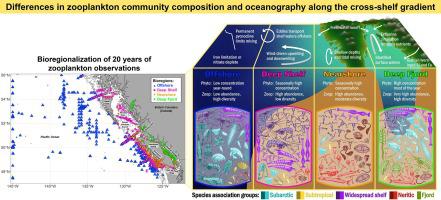Progress in Oceanography ( IF 3.8 ) Pub Date : 2022-06-30 , DOI: 10.1016/j.pocean.2022.102849 Patrick R. Pata , Moira Galbraith , Kelly Young , Andrew R. Margolin , R. Ian Perry , Brian P.V. Hunt

|
Understanding oceanic ecological processes requires identifying biogeographic regions but incorporating the partitioning of planktonic communities, particularly zooplankton, has been limited and difficult. We conducted a data-driven biogeographic regionalization of zooplankton abundance using net data collected during April to October from 1995 to 2014 in the British Columbia, Canada, coastal ocean and adjacent offshore waters. After curating the data and removing rare taxa, a total of 3,721 samples and 160 species were analyzed. K-means cluster analysis of log-chord transformed zooplankton abundances was used to identify four distinct bioregions: Offshore, Deep Shelf, Nearshore, and Deep Fjord. We combined concordance and indicator value analyses to categorize the zooplankton into species association groups. Five main groups representing subarctic, subtropical, widespread shelf, neritic, and fjord specific zooplankton were indicative of specific bioregions but had distributions extending beyond their core bioregion. The spatial coherence of the bioregions and the relative contributions of the association groups to the composition of the bioregions were persistent throughout the 20-year period. The bioregions significantly differed in zooplankton abundance, biomass, and diversity and the community composition varied along the cross-shelf gradient. Variance partitioning demonstrated that the bioregionalization can be mostly explained by the differences in bottom depth, water properties, and phytoplankton concentrations. The cross-shelf differentiation of zooplankton communities was similar to other regionalization studies conducted globally, suggesting the potential for a unified framework of structuring processes and emergent community properties in the epipelagic coastal ocean.
中文翻译:

持久的浮游动物生物区反映了东北太平洋群落组成和海洋学驱动因素的长期一致性
了解海洋生态过程需要确定生物地理区域,但将浮游群落特别是浮游动物的划分结合起来是有限且困难的。我们使用 1995 年至 2014 年 4 月至 10 月期间在加拿大不列颠哥伦比亚省、沿海海洋和邻近近海水域收集的净数据,对浮游动物丰度进行了数据驱动的生物地理区域化。在整理数据并去除稀有类群后,共分析了 3,721 个样本和 160 个物种。对数弦转换的浮游动物丰度的 K 均值聚类分析用于识别四个不同的生物区:近海、深陆架、近岸和深峡湾。我们结合一致性和指标值分析将浮游动物分类为物种关联组。代表亚北极、亚热带、广泛大陆架、浅海和峡湾特定浮游动物的五个主要组群表明了特定的生物区,但分布超出了它们的核心生物区。在整个 20 年期间,生物区的空间连贯性和关联组对生物区组成的相对贡献是持续的。各生物区在浮游动物丰度、生物量和多样性方面存在显着差异,群落组成沿跨陆架梯度变化。方差划分表明,生物区域化主要可以通过底部深度、水特性和浮游植物浓度的差异来解释。浮游动物群落的跨货架分化与全球进行的其他区域化研究相似,











































 京公网安备 11010802027423号
京公网安备 11010802027423号